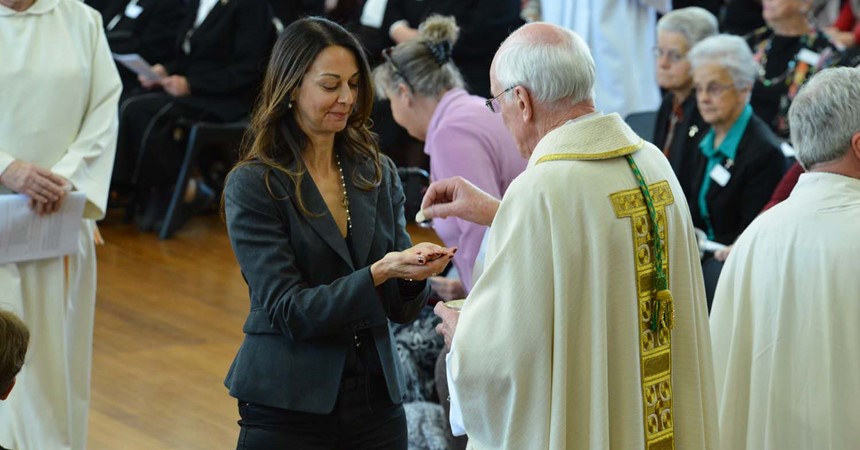The document was written in response to questions that emerged from the community. It was therefore important that the Council engaged the community in conversation about it. I think everyone went away enriched by the reflections and local practices that were shared by members from different communities.
Fr Andrew Doohan and I were privileged to participate in all three conversations. Each one provided us with a lot of food for thought and discussion with Bishop Bill. I anticipate there will be an updated document in the near future.
I thought it would be good to share some of the fruits of the conversations with everyone so we can all continue to ponder:
Some found the notion of ‘guidance’ challenging, wanting to be told the right way to do things to ensure the ‘communion rite’ is celebrated exactly the same in every place. Hopefully, the nature of our document and the conversations have dispelled this notion which is not true to the nature of Catholic liturgy. The document provides some background and guidelines. It is up to each community to reflect on these and then consider how best to celebrate the communion rite in its particular church. The important thing is that the celebration of the rite embodies its deepest meaning.
The document made no comment on The Lord’s Prayer. However, conversation raised the issue of the people extending their arms during the prayer and whether or not this was ‘permitted’. To pray with arms extended is known as the ‘orans position’ and it is an ancient practice. The Missal and the General Instruction of the Roman Missal (GIRM) say nothing about this which means people are free to extend their arms when praying the Lord’s Prayer if so moved. This freedom also means nothing regarding this should be imposed. It was also noted that the ‘orans’ position belongs to the liturgy not the clergy. Therefore, when lay people lead liturgy, as happens at Sunday Celebrations of the Word, the lay leader prays with arms extended as appropriate.
The Sign of Peace generated a lot of conversation. This points to the need for catechesis to assist the community to distinguish between the normal human greeting we give each other before and after Mass, and the sign of peace. The former is focuses on the individual and the latter focuses on Christ. In the Sign of Peace we are acting sacramentally as the Body of Christ to exchange the peace of Christ. It takes the whole community to do this. I don’t have to do it all. The priest doesn’t have to do it all. We all contribute to making that sign real, by exchanging it with integrity to those around us.
The Fraction Rite also generated wide-ranging conversation, mainly about what to do and when to ensure nothing distracts from this action. In one conversation, people’s reflection was taken to a much deeper level when someone shared his insight into the meaning of this action. It is, of course, the third moment in the four part Eucharistic action: Take, Bless, Break, Give. There can be no giving without the breaking. Christ’s body broken and that we might have life in all its fullness. There is much to ponder about this.
The importance of silence was raised in one conversation. The Communion Rite has a momentum that continues to build and should not be interrupted. Step by step we are heading towards communion. Then, according to the Missal, the communion procession ends with a period of silence, ‘for some time’ the GIRM says. This is the time for personal prayer. This is the time to reflect on what we have just done so that we live our Amen each day. Interestingly the Missal refers to this silence as ‘if appropriate’ and with the GIRM says it ‘may’ be observed. That said, pastorally, if the liturgy does not allow people moments for personal prayer at the appropriate time, some will turn elements that are essentially communal, for example the communion procession, into personal moments. The Assembly needs both.
Communion also prompted much conversation. Typically the use of the tabernacle was much discussed. Hopefully what the document says will provide communities with another opportunity to do their best to ensure the tabernacle is not used regularly for the distribution of communion at mass. An interesting point was raised about clergy who use a separate ‘priest’s host’ which they consume entirely. Such a practice is contradictory to our Catholic understanding of eucharist. The DLC will reflect further on this.
Blessings of children and non-communicants in the communion procession always sparks good conversation. While we need to do a lot more thinking and talking about this, essentially, irrespective of age, people are to be left free and not directed to come forward for a blessing, particularly for reasons of convenience of movement. If the Spirit moves a person to come forward for a blessing that’s fine.
In the conversation about what to do and say for this blessing, Paul O’Neill shared what they do in the Chisholm Region. It is different to the approach outlined in the document and is worth sharing with everyone. Ministers of communion (ordinary and extraordinary) silently trace the sign of the cross on the forehead of the person who comes forward. This silent action draws its meaning from the Rite of Baptism where the minister, parents and godparents silently mark the child with the sign of the cross. There was much enthusiasm about this practice and its rationale.
Throughout the conversations we tended to get stuck on the ‘exceptional’ cases. The ‘what ifs’. While these circumstances need to be noted, they do not shape the liturgy. The liturgical principles and guidance such as that provided in our Communion Rite document deal with the normative situation of the Church’s public worship. We use these as our guidelines for responding pastorally to the exceptional cases. The exceptional cases do not dictate the norm or make the rule.
Another overarching theme was the need for catechesis or formation. We encourage communities to consider how they might approach this. Such catechesis on elements of the Mass can be included in the homily from time to time, particularly when the readings speak specifically to a particular element.
If you did not have the opportunity to participate in one of the conversations the document is available on the diocesan website. We recommend that parish leaders, and liturgy teams and ministers take time to read the document and reflect on the celebration of the communion rite in your community. Enjoy the journey.

